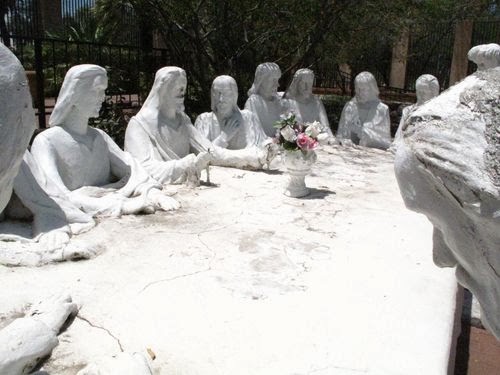Sculptors are pushing the new digital tools, both to create works in traditional materials, and to expand into those new virtual 3D spaces, where no man has gone before.
"
Twister," by Dan Collins, is a seminal
digital-to-physical sculpture. The artist took a digital scan of his body, and ultimately made a casting in bonded marble, 7 feet tall, in China. We will be exhibiting a smaller version, derived from a 3D printer:
Another
digital-to-physical sculpture. The 4 inch sitting female figure below by
Alison Aragon, was
3D printed in bronze! Originally it was a larger clay sketch, 3D scanned at
Metalphysic in Tucson, then sent off to
iMaterialise to be 3D printed:
*****
The Xerocraft hackerspace built a
portable 3D printer --the Printbot Jr -- so that we can print small plastic objects at the sculpture festival:
People can quickly design objects online, in
Tinkercad, to make on the portable 3D printer:
Xerocraft also has an Ultimaker in their shop, to 3D print in PLA plastic. This skull was 3D scanned using a regular digital camera, and then made into a printable 3D file with the free
123D Catch software online:
That same 3D skull file can also be used for displaying the object in
augmented reality:
Recycling that 3D skull file, Xerocraft uploaded it to their
virtual OpenSim world (
which is similar to Second Life), so that the avatar can walk around it:
There is also a dancer in that OpenSim world:
The dancer was first 3D scanned by
Metalphysic, from an oil clay sculpture by
Alison Aragon:
Shapeways printed out the 3D scan larger, but it was not done before the opening:
*****
James Stewart
translated one of Krrrl's figure drawings into a digital object, using 3D software:
However, the resulting file was difficult to 3D print because of the floating pieces. So Krrrl had it 3D laser etched in glass by
Memories in Crystal:
Josiah Grennell used that same 3D digital file to make a
chrome animation:
*****
An original
Susan Kay Johnson bronze rests in front of a large green print of that same face. The bronze was 3D scanned at Metalphysic before it was 3D printed in bright green:
The final artwork does not have to be plastic. Xerocraft
sand casted a beautiful bronze face, from a plastic 3D print, of an
Alison Aragon portrait:
Heatsync hackerspace near Phoenix made a
theromplastic mold from the same 3D print, which could then be used to cast ice cubes or chocolate:
*****
Digiplasty is an ongoing collaborative project. Someone creates a simple "seed" object, which other digital sculptors take and modify with 3D software, to create variations that branch out. James Stewart calls this "shared control."
The below image shows the evolutions from 4 "seed" objects; with 3D prints from just one of these lines, on the sculpture stand below. This Digiplasty exhibit was from at a digital 3D art show last November 2012 --
Generation XYZ:
Of course, any digital 3D object can be displayed in augmented reality (search for
Digiplasty_001):
*****
We will be exhibiting an ancient neo-Sumerian sculpture from the Metropolitan Museum of Art in New York. Xerocraft downloaded and printed a tiny version of Gudea (
in glow-in-the-dark PLA plastic), after the NY Makerbot community had 3D scanned it with 123D Catch, and uploaded it to
Thingiverse:
Metalphysic milled largers versions of Gudea in Styrofoam, and covered one in oil based clay. We will be re-sculpting that ancient piece during the festival, perhaps changing it with a contemporary spin. It could then be cast in bronze:
*****
Heatsync Labs hackerspace in Mesa is lending us their
Strandbeest. This machine could walk as soon as it was 3D printed -- there were no pieces to put together! They bought it from
Shapeways, which now sells a propeller attachment to make the 3D printed version walk in the wind as well:
Jeremy blows into
Gyro the Cube -- which is a machine made of nested 3D prints of cubes. This would be practically impossible to make any other way. Bought from
Shapeways:
*****
Krrrl developed one of his
figure drawings into a clay relief, using an elaborate
digital-to-physical process, that started with a 3D scan by
Align-Rite in Tucson:
3D digital tools, like these
free 3D softwares, are becoming more accessible to the sculptor, and are beginning to have an impact. Perhaps the biggest advantage is that now a sculptor can carry his portfolio in his pocket, on a thumbdrive nestled inside his wallet.
***
One of the 3D body scans from the opening, turned into this 3D print displayed at the closing:




































































